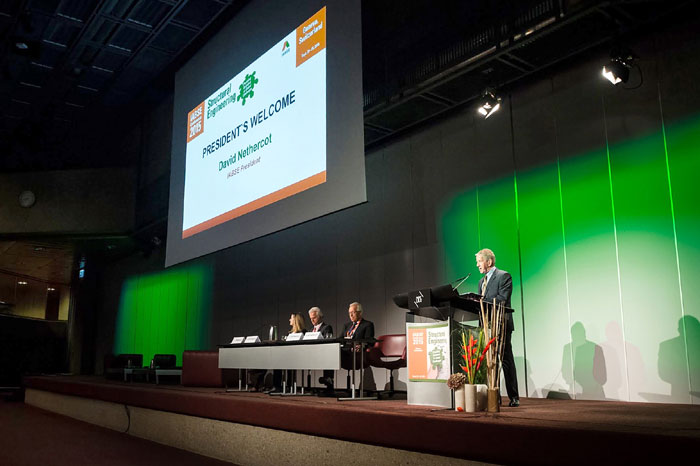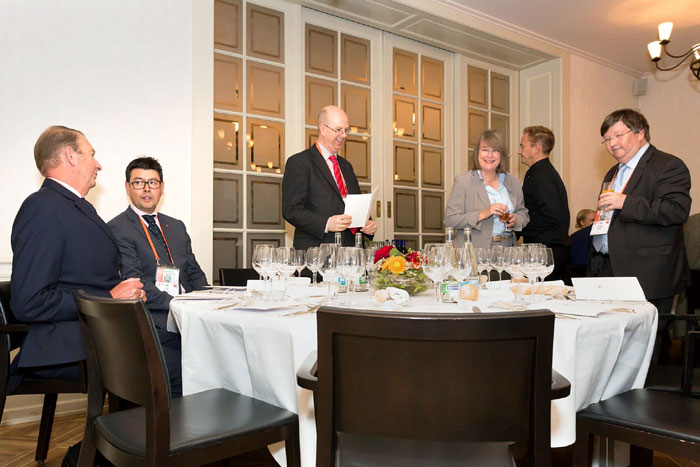Following the establishment of the New Zealand National Group of the International Association of Bridge and Structural Engineering (IABSE), Structural Systems General Manager Dr Stephen Hicks attended the IABSE Conference in Geneva in September 2015.
The conference objective was ‘Providing Solutions to Global Challenges’, which was underpinned by following global themes:
- Climate Change and the Energy Challenge
- Global Engineering Challenges
- Break-through technologies
- Urbanisation and Growth
A new conference style was introduced at this event, which permitted knowledge sharing and to facilitate the maximum number of interactions between conference participants. The ‘Call for Contributions’ on developing Scientific and Technical Sessions that addressed each of the global themes, was open during September and October 2014 and resulted in 135 entries submitted by IABSE Working Commissions, Working Groups and individual members. The subsequent call for abstracts resulted in almost 500 abstracts being received at the end of 2014.
The Technical Session entitled ‘International Design Challenge: Complexity of Design Rules’ was put forward by the members of Working Commission 2 (IABSE WC2) ‘Steel, Timber and Composite Structures’ and was chaired and facilitated by Dr Stephen Hicks and Paul Skelton of Hardesty & Hanover in New York.
A capacity audience of 40 participants, comprising structural engineers and asset owners, listened to the following presentations:


- ‘The New Lifting Bridge in Bordeaux, France – Mechanism Design Code Constraints and Freedoms’ by Skelton and Griesing
- ‘Barriers to Global Adoption of Eurocode 3 and 4’, by Hicks, Uy and Kang
- ‘Concept for the Future Development of Eurocode 3 Design of Steel Structures’ by Kuhlmann and Zizza
- ‘AAEM Versus Numerical Rheology Investigation of Composite Steel-Concrete Beams’ by Partov and Kantchev
- ‘Comparisons Between Design Models for Serviceability Limit State of Composite Steel-concrete Slabs’ by Ranzi, Leoni and Dezi
- ‘Comparison of the Development of AISC and EC4 Code Provisions for Composite Construction’ by Leon
Following the presentations, an animated discussion ensued, which identified the following key areas of concern: performance-based versus prescriptive design (simple versus complex design rules); the need to identify differences between international design standards in order to drive improvements in structural efficiency and encourage harmonization; reconcile design assumptions with product and/or execution standards to ensure that the required safety margins are being maintained; and encourage harmonization of North American and European design practice (new AISC specification expected in 2022, whilst new Eurocodes ready in 2020).
Leveraging off the current membership of IABSE WC2, whom are also represented on AASHTO, AISC, AREMA, Standards New Zealand, Standards Australia, ECCS and the structural Eurocodes, it was concluded that a Working Group should be formed to consider the topics discussed, with a view to producing a new IABSE Structural Engineering Document (SED). To ensure that the initiative provided tangible outcomes within a reasonable timeframe, it was initially proposed to focus on steel and composite construction to form a template for other forms of construction.
In addition to co-chairing the above Technical Session, Dr Stephen Hicks also presented a paper entitled ‘Assessment of Existing Composite Bridges in New Zealand’, which provided interim results from the NZTA project that HERA is working on in collaboration with Opus International Consultants. From a survey of the current New Zealand bridge network, it has been found that the two most used shear connector types in existing bridges are channel shear connectors, followed by welded V-angles.
To date, HERA have identified that the existing equations for channel shear connectors (developed from North American practice), provide overoptimistic predictions; in response to this finding, improved design equations have been developed within the NZTA project (which resulted in a great deal of interest from European members of the audience, as this shear connector type isn’t supported by the current Eurocodes).
With a truly international audience, it also provided a platform to invite the attendees to provide design information from their countries on the other shear connectors that were identified in the NZTA project. However, from feedback from North American, European and Japanese representative, it appears that welded V-angle shear connectors are unique to New Zealand!
The Conference provided many other thought-provoking papers, which addressed the four global themes. A copy of the proceedings is available from our library.
